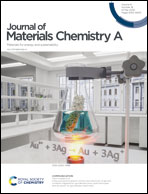Layered VSe2: a promising host for fast zinc storage and its working mechanism†
Abstract
Zinc ion batteries have attracted increasing research attention because of their unique merits (low cost, high safety, etc.). However, poor cycle stability, low energy density and sluggish reaction kinetics are still the major challenges for their further development. Exploring electrode materials with high capacity, durability and fast Zn2+ ion diffusion is crucial to address the aforementioned challenges. Herein, we demonstrate that layered VSe2 with a large interlayer spacing could exhibit excellent Zn storage behavior. Even with a micro-sized morphology, it exhibits a high specific reversible capacity of 250.6 and 132.6 mA h g−1 at 200 and 5000 mA g−1 and good cycle life. The excellent rate performance is comparable to or even higher than those of other nanosized Zn host materials reported in the literature. The good electrical conductivity, large interlayer spacing and pseudocapacitive storage are responsible for its good performance. Combined electrochemical investigation with X-ray diffraction, X-ray photoelectron spectroscopy, X-ray absorption spectroscopy and scanning electron microscopy techniques reveals that VSe2 undergoes an intercalation/de-intercalation process with good structural stability during cycling, accompanied by the redox of the vanadium element.



 Please wait while we load your content...
Please wait while we load your content...